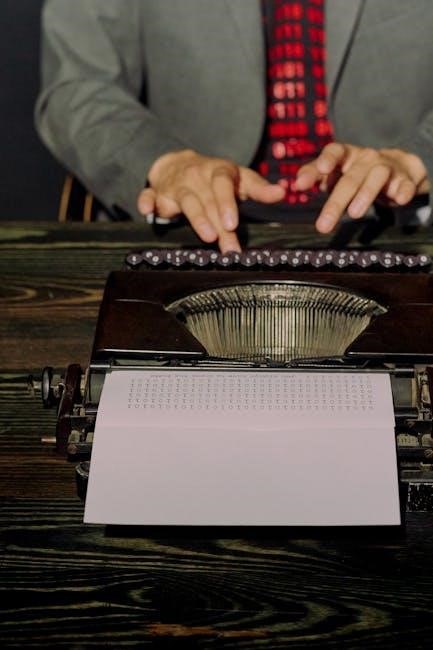A manual pie press is a versatile kitchen tool that simplifies pie-making, offering precision and efficiency. Perfect for homemade pies, tarts, and quiches, it saves time and effort with its simple, user-friendly design, ideal for both home bakers and professionals.
What is a Manual Pie Press?
A manual pie press is a kitchen tool designed to simplify pie-making by forming uniform crusts effortlessly; Made from durable materials like stainless steel or plastic, it allows users to shape dough into perfect circles or specific molds. Ideal for homemade pies, tarts, and quiches, it ensures consistent thickness and texture. Easy to use and clean, it’s a favorite among both home bakers and professionals. This versatile tool streamlines the baking process, making it accessible to all skill levels while producing professional-quality results. Its simplicity and effectiveness have made it a staple in many kitchens worldwide.
Benefits of Using a Manual Pie Press
The manual pie press offers numerous benefits, including uniform crust formation and time-saving convenience. It eliminates the need for rolling dough, reducing effort and potential mess. This tool ensures consistent thickness and texture, resulting in professional-quality pies. Its compact design makes it easy to store, while durability ensures long-term use. Perfect for both beginners and experienced bakers, it simplifies the pie-making process. Additionally, it allows for precise control over dough portions, minimizing waste. With a manual pie press, creating delicious homemade pies becomes efficient and enjoyable, making it a valuable addition to any kitchen for sweet and savory creations alike.

Construction and Materials
Manual pie presses are typically made from durable materials like stainless steel, aluminum, or plastic, ensuring longevity and ease of cleaning. Their sturdy construction guarantees consistent performance.
Common Materials Used
Manual pie presses are crafted from durable materials such as stainless steel, aluminum, and plastic, each offering unique benefits. Stainless steel models are robust and resistant to rust, ensuring longevity. Aluminum presses are lightweight and excellent heat conductors, aiding in even baking. Plastic models are affordable, easy to clean, and lightweight, though less durable. Many presses feature non-stick coatings to prevent dough from sticking, making crust removal effortless. These materials are chosen for their balance of durability, ease of cleaning, and performance, ensuring the press remains functional and hygienic for years.
Design Variations
Manual pie presses come in various designs to suit different baking needs. Compact models are ideal for small kitchens, while larger presses cater to commercial use. Some feature non-stick surfaces for easy crust removal, while others have interchangeable molds for diverse pie sizes and shapes. Certain designs include a removable bottom for effortless pie extraction, enhancing usability. Portability and ease of storage are also key considerations, with some presses designed to be lightweight and foldable. These design variations ensure that bakers can choose a press that aligns with their specific requirements, whether for homemade treats or professional-grade baking projects.

Types of Manual Pie Presses
Manual pie presses come in handheld, tabletop, and interchangeable mold models, catering to different user needs and preferences for ease, portability, and versatility in pie-making.
Handheld Models
Handheld manual pie presses are compact, portable, and easy to use, making them ideal for small batches or personal use. Designed for simplicity, they allow users to shape and form pie crusts with minimal effort. These models are lightweight and ergonomic, fitting comfortably in one hand for precise control. Perfect for crafting individual pies or tartlets, handheld presses are a great option for home bakers who value convenience and ease of storage. While they may lack the capacity of larger models, their portability and affordability make them a popular choice for casual pie-making enthusiasts.
Tabletop Models
Tabletop manual pie presses are a popular choice for home bakers and light commercial use, offering stability and ease of operation. These models are designed for consistent results, with features like interchangeable molds and non-stick surfaces for effortless crust release. Often made from durable materials such as stainless steel or heavy-duty plastic, they provide long-lasting performance. Their compact size makes them ideal for small to medium-sized batches, while some models accommodate larger pies. Easy to clean and store, tabletop pie presses are a practical addition to any kitchen, combining functionality with versatility for both sweet and savory creations.
Models with Interchangeable Molds
Manual pie presses with interchangeable molds offer exceptional versatility, allowing users to create various pie sizes and shapes. These models are ideal for bakers who enjoy experimenting with different recipes, from mini pies to large family-sized desserts. The molds are typically easy to switch, enabling seamless transitions between crust sizes and shapes. This feature is particularly useful for creating uniform crusts and accommodating diverse filling quantities. Many models include multiple molds, while others allow for purchasing additional ones separately. Interchangeable molds enhance creativity and efficiency, making these presses a favorite for both home bakers and professionals seeking adaptability in their pie-making process.

Features and Accessories
Manual pie presses often include built-in cutters, pastry brushes, recipe books, and storage cases, enhancing usability and organization for a seamless pie-making experience.
Built-in Cutter
A built-in cutter is a convenient feature in many manual pie presses, streamlining the pie-making process. It allows users to cut dough to the perfect size for their pie crusts, ensuring uniformity and precision. This feature eliminates the need for additional tools, saving time and reducing waste. The cutter is typically made of durable materials like stainless steel, ensuring long-lasting performance. It is also easy to clean and maintain, making it a practical addition to the press. With a built-in cutter, users can achieve professional-looking crusts without extra effort, enhancing their overall baking experience.
Pastry Brush
A pastry brush is a valuable accessory often included with manual pie presses, designed to enhance the pie-making process. It allows users to apply egg wash, melted butter, or water to the dough, ensuring a golden, flaky crust. The brush is typically made of soft nylon or silicone bristles, gentle on delicate pastry surfaces. This tool is essential for creating a professional finish and adding flavor to the crust. Its compact design makes it easy to store and clean, ensuring it remains a reliable companion for all baking tasks. The pastry brush is a simple yet effective addition to any pie press kit.
Recipe Book
A recipe book is a common accessory provided with manual pie presses, offering a variety of pie recipes and baking tips. It helps users explore different fillings, crust styles, and techniques to enhance their pie-making skills. The book often includes step-by-step instructions, ensuring even beginners can achieve professional results. With recipes ranging from classic desserts to savory dishes, it provides endless inspiration for creating delicious homemade pies. The recipe book is a valuable resource that complements the pie press, making it easier for users to experiment and master various pie-making methods. It’s a great addition for bakers of all skill levels.
Storage Case
A storage case is a practical accessory for manual pie presses, designed to keep the device and its components organized and protected. Made from durable materials like plastic or fabric, it ensures the press remains clean and dust-free when not in use. Many cases feature compartments to store interchangeable molds, cutters, and other accessories, making it easy to transport the pie press. The storage case is a convenient solution for maintaining the tool’s condition and extending its lifespan. It’s a thoughtful addition for bakers who value organization and want to preserve their pie press for years of reliable use.

How to Use a Manual Pie Press
Using a manual pie press is straightforward: prepare dough, place it in the press, add filling, and form the crust for perfectly shaped pies every time, ideal for home and professional use.
Preparing the Dough
Preparing the dough is the first step in using a manual pie press. Ensure the dough is at room temperature for pliability. If using store-bought dough, let it thaw. For homemade dough, chill it in the refrigerator for at least 30 minutes to firm up. Roll the dough on a lightly floured surface to your desired thickness, typically 1/8 inch. Cut portions based on the size of your pie press. Let the dough rest briefly to relax gluten, ensuring it presses evenly. Properly prepared dough ensures a smooth, consistent crust when using the manual pie press.
Placing Dough in the Press
Placing dough in the press requires precision to ensure even crust formation. Begin by cutting a portion of chilled dough to match the press’s size. Lightly flour the dough to prevent sticking. Place the dough in the center of the press, ensuring it aligns with the mold. Gently press the dough into the edges, making sure it fills the mold evenly without stretching. Avoid overfilling, as this can lead to uneven crusts. Proper placement ensures the dough forms a uniform shape, ready for filling and baking. This step is crucial for achieving a professional-looking pie crust.
Adding Filling
Adding filling is a crucial step in the pie-making process. Once the dough is placed in the press, carefully spoon your desired filling into the center, ensuring not to overfill. Distribute the filling evenly, leaving a small border around the edges. For sweet pies, use fruits, sugars, and spices, while savory pies may include meats, cheeses, or vegetables. Gently press the dough over the filling, sealing the edges securely. Avoid overfilling, as this can cause the crust to burst during baking. Proper filling ensures a balanced flavor and a neatly formed pie crust. Always follow recipe guidelines for filling amounts and types.
Forming the Crust
Forming the crust is where the manual pie press truly shines. Once the dough and filling are in place, close the press and apply gentle, even pressure to shape the crust. The press molds the dough into a uniform thickness and seals the edges, creating a professional-looking crust. Ensure the dough is evenly distributed to avoid thin spots. The press’s design helps achieve consistent results, eliminating the need for rolling or hand-shaping. This step is quick and effortless, making it ideal for bakers of all skill levels. The formed crust is ready to bake, delivering a perfectly shaped pie every time.
Baking the Pie
Baking the pie is the final step after using the manual pie press. Preheat your oven to the temperature specified in your recipe, typically between 350°F and 425°F. Place the formed pie on a baking sheet or directly on the oven rack. For single-crust pies, consider blind baking (without filling) for 8-10 minutes. For filled pies, bake until the crust is golden and the filling is cooked through, usually 25-45 minutes. Check periodically to ensure the crust doesn’t burn. Use a pie shield if necessary to protect the edges. Allow the pie to cool before serving for the best results.

Tips and Tricks for Mastering the Manual Pie Press
Mastering the manual pie press involves chilling dough, using the right filling amount, and ensuring the press is clean. Experiment with fillings and dough types for variety and consistency.
Dough Consistency
Achieving the right dough consistency is crucial for successful pie-making with a manual pie press. The dough should be pliable but not too sticky, ensuring it forms evenly without tearing. If the dough is too dry, it may crumble; if too wet, it can stick to the press. To achieve optimal consistency, ensure ingredients are well-mixed and the dough is rested before use. Adjusting the ratio of flour to fat and adding a touch of water or chilling the dough can help reach the perfect texture. Proper dough consistency ensures uniform crusts and a professional finish, making it easier to press and bake pies to perfection.
Gentle Pressing
Gentle pressing is essential when using a manual pie press to avoid misshaping the crust. Applying too much pressure can stretch or thin the dough unevenly, leading to a compromised structure. Use a light, even touch to guide the dough into the mold, ensuring it fills the cavity uniformly. This technique helps maintain the dough’s integrity and promotes a flaky, even texture. Over-pressing can also push filling out or create air pockets, affecting the pie’s appearance and taste. By pressing gently, you achieve a perfectly formed crust every time, enhancing both the visual appeal and flavor of your baked creations.
Experimenting with Fillings
Experimenting with fillings is a great way to unlock the full potential of your manual pie press. From classic fruit fillings like apple or cherry to savory options such as chicken pot pie or spinach and feta, the possibilities are endless. Sweet and savory combinations, like caramelized onions with blue cheese, can create unique flavor profiles. The key is to balance flavors and textures, ensuring fillings are not too runny or overly thick. This versatility allows you to cater to various tastes and dietary preferences, making the manual pie press a tool for creativity in the kitchen.

Cleaning and Maintenance
Regular cleaning and maintenance are essential for prolonging the life of a manual pie press. Use mild soap, warm water, and a soft cloth to prevent residue buildup. Dry thoroughly after cleaning to avoid rust or water spots. Sanitize with a vinegar solution for optimal hygiene. Proper care ensures consistent performance and prevents contamination, keeping your pie press in excellent condition for years.
Importance of Cleaning
Proper cleaning of a manual pie press is vital to maintain hygiene, prevent contamination, and ensure optimal performance. Residual dough and filling can harbor bacteria, leading to foodborne illnesses. Regular cleaning removes stubborn residue, preventing mold and mildew growth. A clean press ensures consistent results and extends its lifespan. Neglecting maintenance can cause mechanical issues or unpleasant odors. Sanitizing with vinegar or mild soap keeps the device safe and functional. Cleaning is essential for both home and professional use, guaranteeing high-quality pies and pastries while preserving the press’s durability and efficiency over time.
Cleaning Methods
Cleaning a manual pie press involves gentle yet effective techniques to remove residue. Start by washing with mild soap and warm water using a soft cloth or sponge. For stubborn dough or filling, use a soft-bristled brush to scrub away debris. Avoid harsh chemicals or abrasive cleaners to prevent damage. Sanitize by wiping with a mixture of equal parts water and white vinegar. For tough stains, soak the press in warm soapy water before scrubbing. Always rinse thoroughly and dry with a clean towel to prevent water spots. Refer to the manufacturer’s guide for specific cleaning recommendations to maintain your press’s condition and functionality.
Drying and Storage
Proper drying and storage are essential for maintaining your manual pie press. After cleaning, dry the press thoroughly with a soft, clean towel to prevent water spots and mineral deposits. Store it in a cool, dry place away from direct sunlight to avoid warping or rust. For added protection, consider using a storage case or protective covering. Ensure all parts are completely dry before storing to prevent moisture buildup. Regularly checking for any remaining moisture will help preserve the press’s condition. Proper storage ensures longevity and keeps the press ready for future use, maintaining its performance and hygiene.

Popular Models and Brands
Popular models include the Model 2200 Hydraulic Press, Dash Mini Pie Maker, and Lakeland Pie Maker, trusted brands known for their quality and reliability in pie-making.
Model 2200 Hydraulic Press
The Model 2200 Hydraulic Press by Comtec Industries is a high-efficiency tool for forming pie crusts. It can produce single or double crust pies, tarts, and cheesecakes with ease. Designed for versatility, it accommodates pans from 1 to 12 inches in diameter. This press is ideal for both home bakers and light commercial use, offering consistent results. Its hydraulic mechanism ensures uniform crust formation, while its durable construction guarantees long-term reliability. Perfect for creating professional-quality crusts, the Model 2200 is a top choice for those seeking precision and efficiency in pie-making. It’s a valuable addition to any kitchen.
Dash Mini Pie Maker
The Dash Mini Pie Maker is a compact, user-friendly appliance designed for crafting mini pies with ease. Perfect for both sweet and savory creations, it simplifies the pie-making process for home bakers. Its portable design and space-saving size make it ideal for small kitchens. The Dash Mini Pie Maker comes with a recipe book, offering inspiration for various fillings and crusts. It ensures even baking, producing perfectly cooked crusts and fillings. This versatile tool is great for those new to pie-making, allowing for experimentation with flavors and ingredients. Its ease of use makes it a delightful addition to any kitchen, perfect for homemade mini pies.
Lakeland Pie Maker
The Lakeland Pie Maker is a high-quality, compact kitchen appliance designed for effortless pie creation. Known for its durability and user-friendly design, it is ideal for home bakers seeking to craft perfect pies. The device features a non-stick coating, ensuring easy crust release and simplified cleaning. It is versatile, accommodating both sweet and savory fillings. The Lakeland Pie Maker is lightweight and compact, making it easy to store in small kitchens. Its ease of use and reliable performance make it a favorite among baking enthusiasts. With its robust construction and practical features, it is a valuable tool for creating delicious, professional-style pies at home.

Manual and Guides
Manuals provide detailed instructions for operating and maintaining manual pie presses, while guides offer troubleshooting tips and step-by-step recipes to enhance your pie-making experience and skills effectively.
Understanding the Manual
Understanding the manual for your manual pie press is essential for safe and effective use. The manual provides detailed instructions on assembly, operation, and maintenance. It outlines safety precautions, such as avoiding improper handling and ensuring the device is clean before use. Step-by-step guides help users master pie-making techniques, while troubleshooting sections address common issues. The manual also includes recipes and tips for achieving perfect crusts. By following the manual, users can optimize performance, extend the device’s lifespan, and create professional-quality pies. Proper understanding ensures a seamless baking experience, making it a valuable resource for both beginners and experienced bakers.
Troubleshooting Common Issues
Troubleshooting common issues with a manual pie press ensures optimal performance and consistent results. If dough sticks to the press, lightly dust it with flour. For uneven crusts, check dough consistency and ensure even distribution. Cracks in the crust may indicate overworking the dough or insufficient moisture. Refer to the manual for guidance on adjusting these factors. Cleaning difficulties can be resolved with a soft brush or vinegar solution. Regular maintenance, such as drying thoroughly after cleaning, prevents rust and extends longevity. Addressing these issues promptly ensures smooth operation and perfect pie crusts every time.

Comparison with Automatic Pie Presses
A manual pie press offers a cost-effective, portable alternative to automatic pie presses, ideal for home bakers or small-scale production. Unlike automatic models, manual presses require no electricity, making them more versatile for various kitchen setups. While automatic presses are faster and suited for high-volume use, manual presses provide precise control over crust formation, ensuring customization. Maintenance for manual presses is simpler, as they lack complex mechanical components. However, automatic presses save time and labor, making them preferable for commercial settings. The choice depends on baking needs, with manual presses excelling in accessibility and ease of use.
A manual pie press is a practical and versatile tool that simplifies pie-making for both professionals and home bakers. Its ease of use, affordability, and ability to produce uniform crusts make it a valuable addition to any kitchen. With various models available, users can choose the perfect press to suit their needs. Whether for sweet or savory pies, the manual pie press delivers consistent results, ensuring delicious homemade creations. Its durability and low maintenance further enhance its appeal, making it a timeless investment for bakers of all skill levels. Embrace the art of pie-making with this essential kitchen companion.